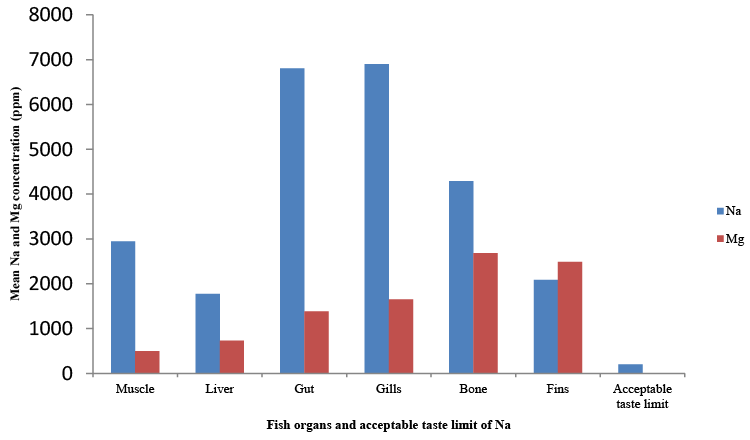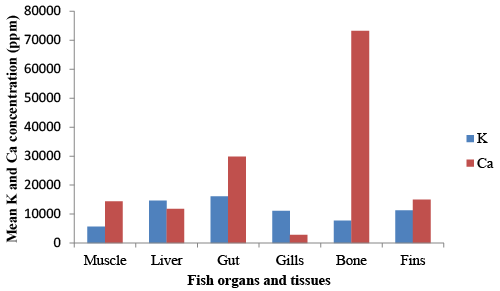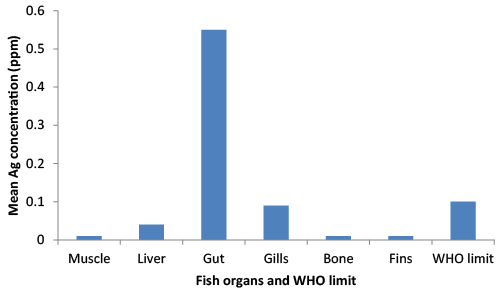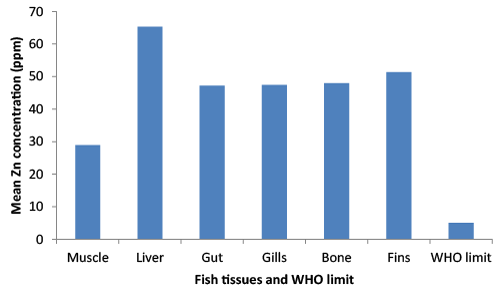- International Journal of Pure and Applied Zoology (2016) Volume 4, Issue 2
Bioaccumulation Of Some Metals In The Fish Sarotherodon Galilaeus Caught From Alaro Stream In Ibadan
| Emmanuel Tyokumbur* Department of Zoology, University of Ibadan, Ibadan, Nigeria |
| Corresponding Author: Emmanuel Tyokumbur, E-mail: e.tyokumbur@mail.ui.edu.ng |
| Received 18th February 2016; Accepted 13th April 2016; Published 23rd April 2016 |
Abstract
Studies were carried out on the bioaccumulation of some metals in the fish Sarotherodon galilaeus caught from Alaro Stream in Ibadan. Previous studies have shown that fish can bioaccumulate and retain some metals from their environment which is dependent on exposure concentration, temperature, water hardness and metabolism of the animals, duration, as well as other factors such as salinity and lipid levels. In this study, the bioaccumulation of the some metals namely sodium (Na), potassium (K), calcium (Ca), magnesium (Mg), silver (Ag) and zinc (Zn) in the fish Sarotherodon galilaeus caught from Alaro Stream in Ibadan was studied to ascertain the health risks associated with human consumption of the fish. The results showed that all the mean Na in the organs and tissues of S. galilaeus exceeded the recommended taste limit of 200 ppm. The highest mean Mg was in the bone (2684 ppm) while the lowest was 498 ppm (muscle) in the order: muscle
Keywords |
||||||||
| Bioaccumulation, Metals, Sarotherodon galilaeus, Fish, Ibadan | ||||||||
INTRODUCTION |
||||||||
| Pollution of the aquatic environment by some metals and other inorganic chemical substances has been considered a major threat to the aquatic organisms including fishes (Saeed and Shaker, 2008). Some metal ions can be incorporated into food chains and concentrated in aquatic organisms to a level that affects their physiological state (Mason, 2002). Some metals such as Zn, Cu and Fe play a biochemical role in the physiological processes of all aquatic plants and animals hence they are essential in the aquatic environment in trace amounts when the optimal levels are not exceeded (Saeed and Shaker, 2008; Mason, 2008). Since some metals cannot be biodegraded, they are deposited, assimilated or incorporated into water, sediment and aquatic animals thereby causing metal bioaccumulation and pollution in water bodies ((Linnik and Zubenko, 2000; Malik et al., 2010, Abdel-Baki et al., 2011). Hence, some metals can be bioaccumulated and biomagnified through the food chain and finally consumed by human consumers resulting in potential health risks (Agah et al., 2009). Studies have shown that fish are able to accumulate and retain some metals from their environment which is dependent on exposure concentration, temperature, water hardness and metabolism of the animals, duration, as well as other factors such as salinity (Allen, 1995). As a result, fish are often used as bioindicators of some metal contamination in the aquatic ecosystem because they occupy high trophic levels and are an important source of proteins, vitamins, minerals and omega-3 fatty acids (Agah et al., 2009, Abdel-Baki et al., 2011). Since the toxic effects of metals have been recognized heavy metal levels in the organs and tissues of aquatic animals are occasionally monitored and compared with acceptable permissible limit standards (Canli et al., 1998). In this study, the bioaccumulation of some metals in the fish Sarotherodon galilaeus caught from Alaro Stream in Ibadan is studied with the objective of ascertaining the health risks associated with the consumption of the studied fish. | ||||||||
MATERIALS AND METHODS |
||||||||
| Sampling site | ||||||||
| The sampling site is Alaro Stream which is located within the hydroecological system of the Oluyole Industrial Estate in Ibadan, Nigeria. The stream receives effluents from diverse sources of some metal pollution. It flows into Oluyole Estate in a west to south east direction from its source at Agaloke near Apata in Ibadan, Oyo State, Nigeria. It forms a confluence at the south east fence of an animal products factory as its main tributary. The effluents from both natural and anthropogenic sources are discharged into Alaro stream directly or indirectly through industrial discharges, run-off, leachate or direct seepage especially during the wet season or as windblown materials during the dry season. The Oluyole Industrial Estate is located between Latitude 7° 21’N -7° 22’N and Longitude 3° 50’-3° 52’E. | ||||||||
| Sample collection and processing for analyses | ||||||||
| The fish were collected from Alaro stream downstream of the industrial effluent discharge points. The fish were collected cast nets with mesh sizes ranging between 30-50 mm with varying dimensional sizes. The nets were cast and left for about three minutes before pulling with a drawing string to check for any trapped fish. Gill nets with mesh size of 30-50 mm were also tied to stakes with a lead weight on the stream bed and maintained vertically in water with the aid of floats overnight. | ||||||||
| Twenty five (25) fishes were caught in the sampling from Alaro stream and used in the study. The collected fish were identified using the key provided by Moses (1992). Dissections were carried out using dissecting set to remove the gills, fins, gut (intestine), liver, bones and muscle (flesh). The organs and tissues were oven dried at 105°C for 6 hours. Each organ was powdered through pulverization separately by means of a porcelain mortar and pestle. The pulverized samples in powder form were kept in Ziploc bags prior to acid digestion. | ||||||||
| Acid digestion of pulverized fish organs and tissues for metal analyses | ||||||||
| Fish organ and tissue digestion was carried out by adding 2 mL trace metal grade HNO3 to 0.5 g of each powdered sample of fish separately in Teflon digestion tubes and heated at 105°C for 1 hour in a heat block. The resulting clear solution was then allowed to cool, followed by addition of 1 mL H2O2. . After the simmering reaction, it was boiled and left overnight. The digested sample was then diluted to the 10 mL mark using MilliQ water. This was then transferred into test tubes rinsed with deionized water for Inductively Coupled Plasma Mass Spectrometer (ICP-MS) analyses for metals. | ||||||||
| Standard Reference Materials (SRM) used for assessing recovery rates of metals by the ICP-MS was bovine liver obtained from the National Institute of Standards and Technology (NIST-1577) were used to obtain accurate values for fish organs. Bovine liver was chosen because it is in the same powdered form and of an animal source just like the analyzed samples in the study. ICP-MS was preferred to other facilities for metal analyses because it is a rapid, precise, accurate, and extremely sensitive multielement analytical equipment for biological samples. | ||||||||
RESULTS AND DISCUSSION |
||||||||
| The results of the mean metal concentration in the organs and tissues of S. galilaeus are shown in Figures 1 to 4. | ||||||||
| Variation in some metal concentrations in the organs of S. galilaeus can be attributed to the route of exposure such as through diet or their elevated level in surrounding environment (Nussey, 2000; Akan et al., 2012). Findings from this study corroborates results from research on metals in fish from other ecological zones such as the following. Canli et al., (1998) found elevated levels of some metals All the mean Na in the organs and tissues of S. galilaeus exceeded the recommended taste limit of 200 ppm (WHO, 2008). The highest mean Na was recorded in the gills (6899 ppm) while the lowest was 1776 ppm (liver) in the increasing order: liver<fins<muscle<bone<gut<gills. The highest mean Mg was in the bone (2684 ppm) while the lowest was 498ppm (muscle) in the increasing order: muscle<liver<gut <gills<fins<bone. | ||||||||
| The highest mean K was 16143 ppm (gut) while the lowest was 14426 ppm (muscle) in the increasing order: muscle<b one<gills<gills<liver<gut. The highest Ca level was 73216 ppm (bone) while the lowest mean was recorded in the gills (2806 ppm) in the increasing order: gills<liver<muscle<fins <gut<bone. | ||||||||
| (Cd, Pb, Cu, Cr and Ni) in tissue of Cyprinus carpio, Barbus capito and Chondrostoma regium from the Seyhan River in Turkey. Papagiannis et al., (2004) found that fish tissues analyses of some metals revealed that the liver and gonads accumulated the highest levels of Cu and Zn while C. carpio and R. ylikiensis presented the highest metal content. Jezierska and Witeska (2006) reviewed various studies confirming the environmental health threat of metal uptake in fishes in a study on the metal uptake and accumulation in fish living in polluted waters. Abdel-Baki et al., (2011) found that the metals Pb, Cd, Hg, Cu and Cr bioaccumulated in fish in the edible parts of Tilapia fish which were within the safety permissible. From this corroborative studies and the results from this study, it can be asserted that metal pollution poses a health threat to humans through the consumption of fish from The highest mean Ag was recorded in the gut (0.55 ppm) while least was 0.01 ppm (muscle, bone and fins) in the increasing order: muscle and fins, muscle and bone<liver<gills<gut. With the exception of the gut (0.55 ppm), all the other organs had mean Ag below the World Health Organization permissible limit guideline standard of 0.1 ppm. | ||||||||
| All the mean Zn levels in the organs and tissues of S. galilaeus were above the WHO permissible limit guideline standard of 5 ppm. The highest mean Zn concentration was 65.3 ppm (liver) while the lowest was 28.9 ppm (muscle) in the increasing order: muscle<gut<gills<bone<fins<liver. | ||||||||
| this ecological system. This is so because it is the chronic dose uptake of some metals that is hazardous to human health in the long run even as some mean levels were above World Health Organization’s permissible limit guideline standards as shown in the results of this study. | ||||||||
Figures at a glance |
||||||||
|
||||||||



